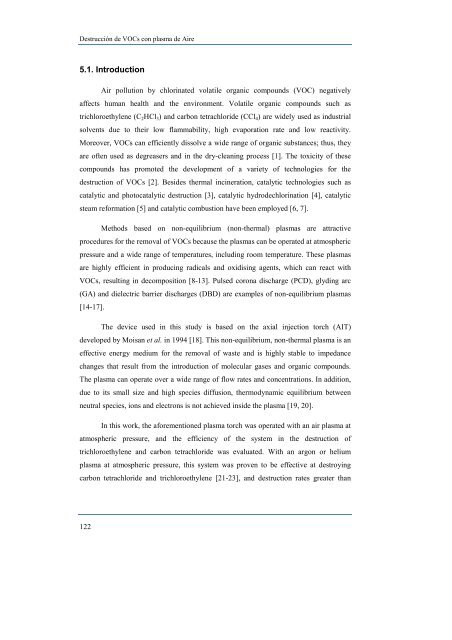estudio y caracterización de un plasma de microondas a presión ...
estudio y caracterización de un plasma de microondas a presión ...
estudio y caracterización de un plasma de microondas a presión ...
You also want an ePaper? Increase the reach of your titles
YUMPU automatically turns print PDFs into web optimized ePapers that Google loves.
Destrucción <strong>de</strong> VOCs con <strong>plasma</strong> <strong>de</strong> Aire<br />
5.1. Introduction<br />
122<br />
Air pollution by chlorinated volatile organic compo<strong>un</strong>ds (VOC) negatively<br />
affects human health and the environment. Volatile organic compo<strong>un</strong>ds such as<br />
trichloroethylene (C2HCl3) and carbon tetrachlori<strong>de</strong> (CCl4) are wi<strong>de</strong>ly used as industrial<br />
solvents due to their low flammability, high evaporation rate and low reactivity.<br />
Moreover, VOCs can efficiently dissolve a wi<strong>de</strong> range of organic substances; thus, they<br />
are often used as <strong>de</strong>greasers and in the dry-cleaning process [1]. The toxicity of these<br />
compo<strong>un</strong>ds has promoted the <strong>de</strong>velopment of a variety of technologies for the<br />
<strong>de</strong>struction of VOCs [2]. Besi<strong>de</strong>s thermal incineration, catalytic technologies such as<br />
catalytic and photocatalytic <strong>de</strong>struction [3], catalytic hydro<strong>de</strong>chlorination [4], catalytic<br />
steam reformation [5] and catalytic combustion have been employed [6, 7].<br />
Methods based on non-equilibrium (non-thermal) <strong>plasma</strong>s are attractive<br />
procedures for the removal of VOCs because the <strong>plasma</strong>s can be operated at atmospheric<br />
pressure and a wi<strong>de</strong> range of temperatures, including room temperature. These <strong>plasma</strong>s<br />
are highly efficient in producing radicals and oxidising agents, which can react with<br />
VOCs, resulting in <strong>de</strong>composition [8-13]. Pulsed corona discharge (PCD), glyding arc<br />
(GA) and dielectric barrier discharges (DBD) are examples of non-equilibrium <strong>plasma</strong>s<br />
[14-17].<br />
The <strong>de</strong>vice used in this study is based on the axial injection torch (AIT)<br />
<strong>de</strong>veloped by Moisan et al. in 1994 [18]. This non-equilibrium, non-thermal <strong>plasma</strong> is an<br />
effective energy medium for the removal of waste and is highly stable to impedance<br />
changes that result from the introduction of molecular gases and organic compo<strong>un</strong>ds.<br />
The <strong>plasma</strong> can operate over a wi<strong>de</strong> range of flow rates and concentrations. In addition,<br />
due to its small size and high species diffusion, thermodynamic equilibrium between<br />
neutral species, ions and electrons is not achieved insi<strong>de</strong> the <strong>plasma</strong> [19, 20].<br />
In this work, the aforementioned <strong>plasma</strong> torch was operated with an air <strong>plasma</strong> at<br />
atmospheric pressure, and the efficiency of the system in the <strong>de</strong>struction of<br />
trichloroethylene and carbon tetrachlori<strong>de</strong> was evaluated. With an argon or helium<br />
<strong>plasma</strong> at atmospheric pressure, this system was proven to be effective at <strong>de</strong>stroying<br />
carbon tetrachlori<strong>de</strong> and trichloroethylene [21-23], and <strong>de</strong>struction rates greater than

















